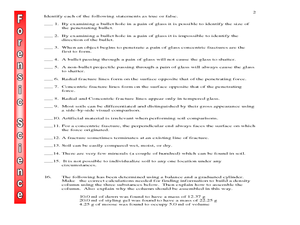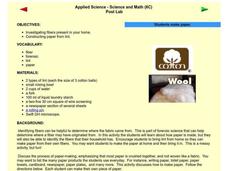Curated OER
Drug Analysis Using Thin-Layer Chromatography
Students use forensic science to positively identify any suspected drugs submitted to the laboratory. They determine the identity of the drugs found in the bodies of drug-overdose victims. Students use TLC to identify the active...
Curated OER
Solving Mysteries Using Paper Chromotagraphy
Students solve the mystery of the kidnapped teacher by analyzing a ransom note using paper chromatography. They carefully prepare ink samples from the note to known ink samples to determine the kidnapper.
Curated OER
Measurable You!
Conduct guided experiments and discussions while collecting anthropometric measurements. Your class will explore impact of experimental errors in a scientific system, and explain their observations/findings in writing. An introduction to...
Curated OER
Glass and Soil
For this forensic science lesson, students sketch bullet line fractures and complete 16 short answer questions on glass and soil evidence.
Curated OER
Hair
In this forensic science learning exercise, students identify the different parts of the hair. They complete 18 short answer questions on how hair evidence is used in forensics.
Curated OER
Hair Test
In this forensic science activity, students answer 3 open response questions about hair evidence collected from the crime scene.
Curated OER
DNA Questions
For this forensic science worksheet, students analyze the characteristics and uses of DNA to complete 26 short answer questions.
Curated OER
Physical Evidence
In this forensics worksheet, students complete 14 short answer questions related to physical evidence. They explain how certain types of evidence are handled upon recovery from the crime scene.
Curated OER
Fingerprinting
In this fingerprinting instructional activity, students write short answers to 16 questions about the principles of fingerprinting. They explain how this method is used to identify criminals.
Curated OER
Interdisciplinary Applications of Chemistry Through Engineering in Modern Medicine
Learners explore the different techniques used in forensic science. In this chemistry lesson, students investigate a fictional crime and identify the culprit. They create a brochure or collage career bulletin.
Curated OER
Cardiac Arrest! Using Forensics to Investigate Cardiovascular Anatomy and Function
Students identify the different parts and functions of the cardiovascular system. In this forensics lesson, students collect and analyze evidence on a fictional crime. They describe different causes of cardiac arrest.
Curated OER
The Case of Similar Substances
Students perform tests in the lab to identify an unknown substance. In this physical science lesson, students observe the physical and chemical properties of substances. They formulate a conclusion based on experimental results.
Curated OER
Applied Science - Science and Math Post Lab
Students construct paper. In this applied Science instructional activity, students create paper using lint. Students investigate the different fibers in their homes.
Curated OER
Crime Scene Documentation
Students become forensic investigators. For this crime scene lesson, students go to the science lab which is the "scene of the crime." They collect evidence such as fingerprints, "blood" evidence, chromatography, footprints, and more.
Curated OER
Name That Tune: Matching Musical Tones Through Waveform Analysis
Pupils detect the waveform of musical notes to determine the code for the "safe" in this forensics simulation lesson. They use a microphone and tuning forks along with Vernier EasyData on their graphing calculator to analyze five musical...
Curated OER
Solving Imaginary Crimes
Students participate in a forensic science activity. In this crime solving lesson, students investigate fingerprints, and other crime scene evidence to solve an imaginary crime.
Curated OER
Recovering the Romanovs
Students use DNA to solve an identity mystery. In this biology lesson plan, students use the Internet to gather information about sex-linked disorders and complete a Punnett square for hemophilia, then examine a handwriting analysis,...
Curated OER
Dead Body Math
Students solve the mystery of dead Mr. Potato Head using physics and algebra. They discuss Newton's Law of cooling as it applies to the mystery scenario involving a cooling baked potato as the "victim". They manipulate algebraic...
Curated OER
The Case of Similar Substances
Middle schoolers solve a crime mystery using chemical tests. They review the crime scenario and then become familiar with the procedure and results for two tests used to identify unknown powders. They perform the tests on the crime...
Curated OER
Who Is It?/Who Done It?
Students conduct an experiment that allows them to assess individual differences in random DNA sequences and apply those differences when solving a forensic problem. After discussing the polymerase chain reaction and its use to identify...
Curated OER
Hunt for the Serial Arsonist
Students prepare study, and graph fingerprint patterns. They create latent fingerprints and look for common features in their prints for classification.In addition, they create a graph showing the distribution of different patterns...
Curated OER
Mission Possible
Students, in teams, solve a crime using forensic lab techniques. They apply lab techniques to a real life situation using a crime scenario that takes place on campus. Sample activities include Blood, Fiber, and Hair Lab.
Curated OER
Trichinella Forensics
Learners engage in DNA manipulation using forensics techniques. Students investigate topics involved in forensics studies such as cloning, electrophoresis, gene mapping, replication, and transcription.
Curated OER
Murder Mystery
High schoolers examine how to capture foot prints while they simulate a criminal investigation. They discover how the clues are needed for identifying or eliminating murder suspects.

























